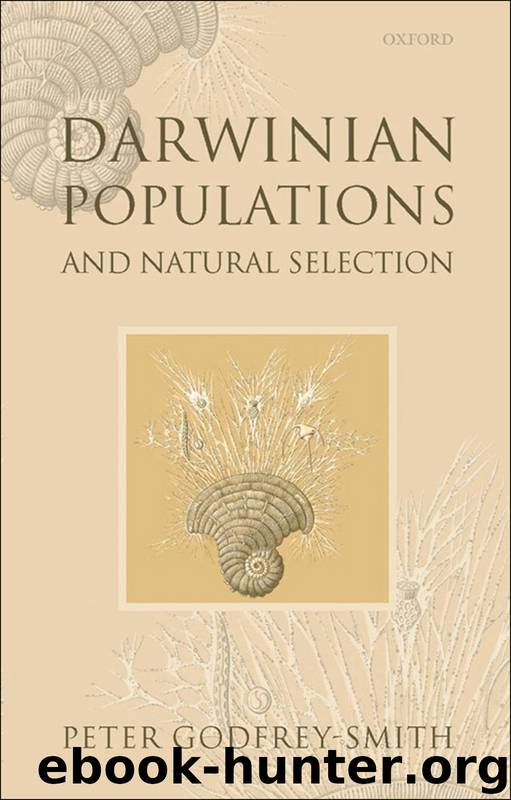Darwinian Populations and Natural Selection by Godfrey-Smith Peter;

Author:Godfrey-Smith, Peter;
Language: eng
Format: epub
Publisher: Oxford University Press, Incorporated
Published: 2009-06-14T16:00:00+00:00
5.5. Summary of the First Five Chapters
Darwinian populations are collections of things that vary, reproduce at different rates, and inherit some of this variation. The basic features of these collections are startlingly routine—births, lives, and deaths, with variation and inheritance. But Darwin saw that this set-up, this arrangement of ordinary features, is an extraordinarily important element of the world. Darwin’s description was empirical and concrete. The last century’s work has included a series of moves towards abstraction, attempting to say what is essential about the Darwinian machine—which features are not dependent on the contingent particularities of life on earth. I continue that tradition, but do so with an eye to another feature of the Darwinian world view. Darwinian populations shade into marginal cases, and the paradigm Darwinian processes depend on ingredients that are themselves evolutionary products and must have come from something simpler. One aim of this book is to give an account of the Darwinian process that is designed to handle this blending-off into marginal cases, precursors, and not-quites.
This account of Darwinism yields a particular picture of the world. One of the world’s constituents is a great range of Darwinian populations: paradigm cases and marginal ones, some clear and others obscure, some powerful and others suppressed. Some are visible and obvious, others invisible. Some are inside others. They tread through their Darwinian behaviors on a great range of different scales in space and time. Some evolve via reproduction of a wholesale and definite kind, others evolve by coopting the biological scaffolding that results. Populations evolve as a consequence of their Darwinian properties, but also change the basis for their further evolution, moving through the imagined spaces of evolutionary parameters. The tree of life is generated by Darwinian populations and what they do—the tree is a structure of lives linked by reproductive events. But reproduction is an evolutionary product, and appears as a different relationship at different places on the tree. Sometimes there is sex, a fresh start, and genetic novelty with every birth; sometimes the appearance of a new organism is imperfectly distinguished from continuation of the same thing. Some Darwinian individuals live inside others, in ways that make it unclear how to count and distinguish them. And sometimes the tree shape is lost due to fusions and hybridizations.
Download
This site does not store any files on its server. We only index and link to content provided by other sites. Please contact the content providers to delete copyright contents if any and email us, we'll remove relevant links or contents immediately.
Sapiens: A Brief History of Humankind by Yuval Noah Harari(14210)
Sapiens by Yuval Noah Harari(5280)
Pale Blue Dot by Carl Sagan(4884)
Homo Deus: A Brief History of Tomorrow by Yuval Noah Harari(4799)
Livewired by David Eagleman(3663)
Origin Story: A Big History of Everything by David Christian(3631)
Brief Answers to the Big Questions by Stephen Hawking(3354)
Inferior by Angela Saini(3260)
Origin Story by David Christian(3132)
Signature in the Cell: DNA and the Evidence for Intelligent Design by Stephen C. Meyer(3054)
The Gene: An Intimate History by Siddhartha Mukherjee(3029)
The Evolution of Beauty by Richard O. Prum(2924)
Aliens by Jim Al-Khalili(2776)
How The Mind Works by Steven Pinker(2713)
A Short History of Nearly Everything by Bryson Bill(2616)
Sex at Dawn: The Prehistoric Origins of Modern Sexuality by Ryan Christopher(2472)
From Bacteria to Bach and Back by Daniel C. Dennett(2432)
Endless Forms Most Beautiful by Sean B. Carroll(2413)
Who We Are and How We Got Here by David Reich(2385)
